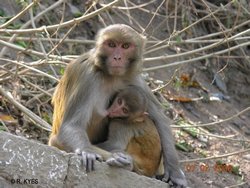
|
 |
Rhesus macaque monkeys in Nepal are suitable alternative for HIV/AIDS research
Jun 1, 2006, 13:24, Reviewed by: Dr. Priya Saxena
|
|
"This program will not harm the natural populations because we will establish the self-sustaining breeding colony with a relatively small number of animals that will be acquired from areas of known human-monkey conflicts,"
|
By University of Washington,
Scientists investigating the genetic makeup of rhesus macaque monkeys, a key species used in biomedical research, have found the rhesus in Nepal may provide a suitable alternative to alleviate a critical shortage of laboratory animals used in work to develop vaccines against diseases such as HIV/AIDS.
Writing in the cover story of the current issue of the American Journal of Primatology, researchers headed by Randall Kyes of the University of Washington report that the Nepali macaques are more closely related genetically to rhesus macaques from India than rhesus macaques of China.
This is important because Indian-origin animals have been used for more than half a century in biomedical and behavioral research. Rhesus macaques have contributed to the discovery of vaccines to prevent diseases such as polio and yellow fever, and represent one of the most widely used primate models for AIDS-related research. India, however, banned the export of all macaques in 1978, thus leading to the current shortage. Although China has been exporting captive-bred animals for sometime, scientists have noted a number of behavioral and physiological differences in disease progression between animals from the two countries, and the Indian-origin macaques are generally preferred in research on certain diseases.
The new study was spearheaded by Kyes, a primatologist and head of the UW's Division of International Programs at the Washington National Primate Research Center, in collaboration with Mukesh Chalise, president of the Nepal Biodiversity Research Society and a zoologist at Tribhuvan University in Nepal.
Blood samples from 21 Nepali rhesus macaques living at a temple site in Kathmandu were obtained as part of a comprehensive health screening conducted at the temple. These samples were compared with existing samples collected from more than 300 Indian- and Chinese-origin rhesus macaques.
 |
| A mother and baby rhesus macaque from Nepal that have been found to be genetically similar to Indian macaques. Picture credits: Randall Kyes |
The researchers did sequence analyses of mitochondrial DNA and examined the distribution of certain types of alleles, or pairs of genes, for genetic variations distributed across 17 chromosomes. They also looked for the presence of other alleles that are known to influence immunity and the rate of disease progression in the animals, including one that is present in Indian rhesus macaques but not in the Chinese ones.
Kyes, who also is a UW research associate professor of psychology, said the genetic analyses indicate the Nepali rhesus macaques are genetically similar to Indian-origin rhesus macaques. In addition, while the temple samples were taken from an isolated population, he believes they may be representative of Nepali rhesus macaques in general given the past history of the area and the geographic barrier of the Himalayan Mountains that separates Nepal and India from China.
To facilitate the use of rhesus macaques in research while ensuring the conservation of Nepal's naturally occurring rhesus populations, the Nepali government enacted a policy in 2003 stipulating that only captive-bred animals may be used for scientific research. The rhesus macaque is prevalent in many countries and is not considered an endangered species. An agreement between the Nepal Biodiversity Research Society and the Washington National Primate Research Center was signed in September 2003 and a captive-breeding facility is now under construction. A breeding colony is expected to be established within 12 months.
"This program will not harm the natural populations because we will establish the self-sustaining breeding colony with a relatively small number of animals that will be acquired from areas of known human-monkey conflicts," said Kyes. "In Nepal, this conflict is caused by monkeys that raid staple crops such as sweet potatoes and corn. Crop raiding is prevalent in many areas in Nepal and in the last five to 10 years there are many instances of local people seeking to solve this problem by chasing or killing macaques.
"One of the goals of our international program is to assist our collaborators in creating the first primate research center in Nepal and to help address some of Nepal's most pressing health concerns that include HIV, tuberculosis, hepatitis and malaria.
"In addition, the program has a strong conservation thrust. Establishing this center will allow more resources to be dedicated to primate conservation in Nepal because it has the potential to generate significant funding that can be directed toward the management and conservation of natural populations. This kind of program has been effective in other habitat countries and is supported by the World Health Organization and the World Conservation Union," he said. 
- American Journal of Primatology
www.washington.edu
The research was supported in part by the National Institutes of Health. Co-authors of the paper are Lisa Jones-Engel, Gregory Engel and Richard Grant of the University of Washington; John Heidrich of the University of New Mexico; Shyam Bajimaya of the Nepal Department of National Parks and Wildlife Conservation; John McDonough and David Smith of the University of California, Davis; and Betsy Ferguson of the Oregon National Primate Research Center.
|
For any corrections of factual information, to contact the editors or to send
any medical news or health news press releases, use
feedback form
Top of Page
|
|
|
|